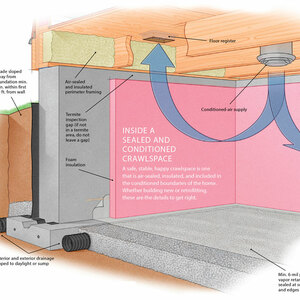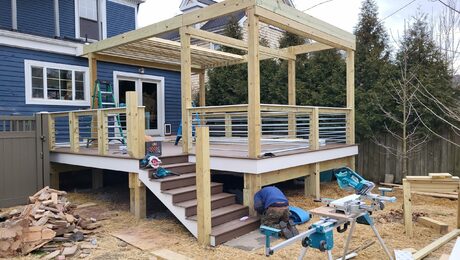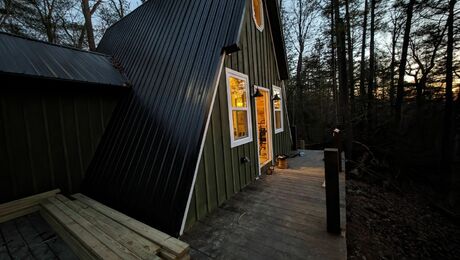Maine School Chooses the Passivhaus Route

If winter ever ends, work will get underway by mid-April on a private school in Belfast, Maine, built to meet the Passivhaus standard. It’s the second such project to be announced in the state within a year.
The 6000-sq.-ft. Cornerspring Montessori School, with 68 students in pre-school through elementary grades, will cost an estimated $1.2 million. The school has already launched a capital campaign to raise a total of $2 million for the school and related programs.
The Belfast architectural and construction firm GO Logic, which already has plenty of Passivhaus experience, designed the new building and hopes to have it completed by September 1, now less than seven months away, says GO Logic’s Tim Lock, the architect in charge of the project.
Lock, along with GO Logic founders Matt O’Malia and Alan Gibson, all have children in the school. When Cornerspring lost the lease for its current home, the firm helped its board of directors look at alternatives. They scouted properties in Belfast to see if any might be renovated but eventually concluded that buying land and building something that made more sense.
In a press release, Cornerspring board president Josh Birocco said the new building would reflect the values of the school and the community. The board approved the purchase of 35 acres of land last fall as well as GO Logic’s design for the new building. The “Journey Home” capital campaign had raised $356,000 by early February.
Cornerspring would become the second private school in the state to announce plans for a Passivhaus building recently. The Friends School of Portland is at work on a 15,000-sq.-ft. school scheduled for completion by summer, also to take the place of leased space.
Where schools differ from houses
GO Logic is no stranger to Passivhaus design. The firm has built both houses and institutional buildings in the past, including the Warren Woods Ecological Field Station at the University of Chicago, what the firm says is the first certified Passivhaus laboratory in North America.
“The big difference in going to institutional, be it a school or something like the field station, is that the occupant load, the internal heat gain from occupants and equipment, is just so much different than a residence,” Lock said, “and because of that it actually does start to inform design a little differently.”
In a house occupied by a couple or family, siting the building for solar gain is key to reducing the overall heat demand, Lock said. But in the case of a lab, which has lots of heat-generating equipment, or the Cornerspring school, with as many as 100 occupants at a time, priorities change.
“Those things start to offset potential solar gains pretty quickly,” Lock said, “and makes you rethink that perfect south building orientation that might be really beneficial in a residence all of a sudden is not quite so beneficial in an institutional building. Not that it’s a detriment, but it’s not something that’s necessary to achieve the [Passivhaus] standard.”
The school said the superefficient Passivhaus design will help it save $7500 a year on space heating, which over a 25-year span would add up to $600,000 when factored for inflation. The building will have five classrooms and six bathrooms.
GO Logic will be seeking certification through Germany’s Passivhaus Institut (PHI) rather than the Passive House Institute U.S. (PHIUS), mainly because PHI seems to have more experience with this type of construction and was very helpful as the firm sought certification for the University of Chicago project. “We had a really good experience working with PHI,” Lock said.
Many details are still to be determined
GO Logic has decided on many of the basic details for the building, including the wall and roof assemblies, the thickness and type of insulation, and specs for windows. But many other decisions are yet to be worked out.
Here’s how the building is shaping up:
- Foundation: Frost-protected slab-on-grade insulated with 8 inches of expanded polystyrene (EPS) insulation for R-33.6.
- Walls: A 2×6 stud wall insulated with dense-pack cellulose and insulated with 8 inches of EPS and clad with a Sto exterior insulation and finish system (EIFS) with an acrylic stucco top coat. On gabled parts of the building, the cladding will be locally sourced eastern white cedar, also insulated with 8 inches of EPS. Wall R-values will be about 52.
- Roof: Pitched roofs will be capped with 24-ga. Galvalume standing-seam roofing; flat sections will be finished with an EPDM membrane. The roof will be insulated with 24 in. to 30 in. of dense-pack cellulose, with R-values from R-82 to R-105.
- Windows: Kneer-Sudfenster is supplying the triple-glazed windows.
- Mechanicals: Domestic hot water will be provided by an electric hot water heater. Whole-building ventilation will be provided by a Zehnder, but it’s undecided whether it will be a heat-recovery or energy-recovery model. The heating and cooling system has yet to be determined.
Whether the building gets any renewable energy equipment will be determined by the school at a later date, Lock said.
Asked about the choice of the EIFS exterior, Lock said the project is still in the decision phase, and that could change. But at the moment, EIFS seems to offer a number of advantages:
“We are interested in taking on a challenge of EIFS,” Lock said in a followup email. “It represents a significant reduction in shell cost (less finish cost, no need for window jamb and head exterior trim), while offering the same insulation properties as EPS [structural insulated panels] (if not more, depending on thickness).
“In our trips to the Passive House conference in Germany we have seen that STO offers EIFS in Europe over a mineral wool insulation (with high compression resistance) instead of EPS,” he continued. “We would love to be able to have access to that here, alas, we do not–maybe in the future. We have admired simple, European acrylic stucco buildings from afar for some time, and are interested in trying it for ourselves. We feel that given a playful and kid-friendly fenestration strategy, the simplicity of the monolithic finish will look very compelling. “























